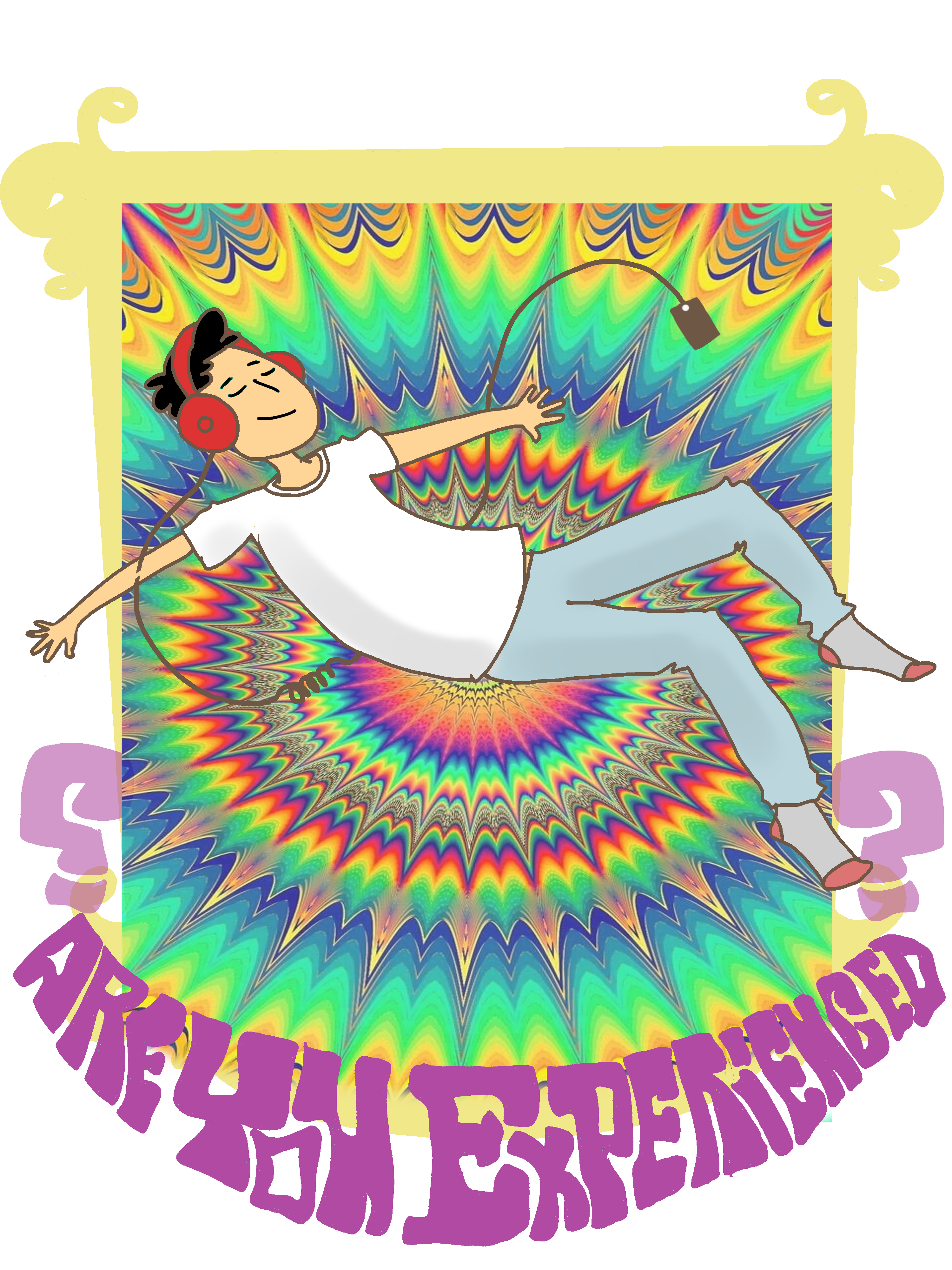
Music is more influential than most of us assume. On average, music influences our emotions during two of three encounters with it. Arguably, there are large individual differences in such emotions (Juslin & Laukka, 2004), but discovering how certain emotions and experiences tied to these emotions are induced by music can make our lives more pleasant by helping us experience more positive emotions.
Music is more influential than most of us assume. On average, music influences our emotions during two of three encounters with it. Arguably, there are large individual differences in such emotions (Juslin & Laukka, 2004), but discovering how certain emotions and experiences tied to these emotions are induced by music can make our lives more pleasant by helping us experience more positive emotions.

Illustratie: Carolien de Bruin
Many people around the world experience music with their ‘whole body’. In other words, we usually embody music: it involves not only cognition and emotions, but also sensations and behaviour at once (Levinson, 2000). An example of such embodiment that is strongly linked to emotions is musical frisson, which is the well-known ‘pleasant tingling feeling’ when we are aroused, with goose bumps on our skin and raised body hairs (Harrison & Loui, 2014). The relationship between emotion and musical frisson is a complex one. There is evidence that music induces emotions which, in turn, produce frisson, but also that music can induce frisson which, by context and appraisal (cognitive evaluation), induces the emotion. On top of that, frisson determines not only the valence, but also the intensity of the emotion we are experiencing (Harrison & Loui, 2014). Evidence from neuroscience supports the positive valence of the musical frisson: frisson-inducing music activates brain areas associated with reward systems (Salimpoor, 2011). It would be interesting to find out exactly how frisson usually comes about. In other words, what makes some music more likely to induce this pleasant experience? Knowing this, we could perhaps help ourselves induce frisson too. To help us find just what the frisson-inducing music is, we will use Juslin’s (2008) model of emotions elicited by music. Three elements of frisson-inducing music will be covered: surprise, learned associations, and emotional contagion.
“context, as well as appraisal, play a role in the valence of a frisson”
Surprise: Watch Out, Potential Danger Ahead
As every good psychology student knows, there are some ancient brain systems allowing humans to quickly scan the environment for any danger. We have surely heard a lot about the fight or flight system, usually in connection with some people hearing suspicious animal sounds in a nearby patch of tall grass. Well, the same automatic and unlearned brainstem reflexes that check for any possibly important or urgent event in our surroundings also operate when we listen to music: a sudden change in volume, rhythm or timbre surprises us and makes us pay immediate attention to it (Juslin, 2013). That is because our hearing mechanism does not take into account the source of various cues when assessing them (Nesse, 2009). In other words, our attention increases regardless of whether we hear an animal lurking or a sudden crescendo by the London Symphony Orchestra. Both cues signal that there’s something extraordinary going on.
An often-studied mechanism that also leads to surprise and leads to frisson is a violation of expectations. Consider the following example: You are at the theatre, watching the ballet. An intense scene where the main character has to leave the love of his life. Then, the orchestra falls completely silent for a few moments. You’ve got goosebumps. Why? You expected the music to continue, and therefore your expectations have been violated. We, humans, are peculiar creatures. On the one hand, we cherish predictable music, something we can expect based on our previous experience. That is also why the sonar has been termed ‘the ugliest music ever’. It’s simply a bunch of sounds without any emerging pattern. On the other hand, small breaks in our expectations are sometimes welcomed, as we react with surprise to sudden dynamic leaps, chord changes and delays in the music that we’re hearing (Juslin, 2013). When we are surprised, our autonomic nervous system is aroused, which is marked by increased heart rate and deeper breathing (Craig, 2005). As a consequence, frisson is likely to ensue (Goldstein, 1980). Of course, it is questionable whether a frisson induced by stress is a pleasant one. Therefore, it is safe to assume that context, as well as appraisal, plays a role in the valence of a frisson. In other words, if we experience frisson while realising that we are in the theatre and not in the jungle, our experience of frissons is likely to be positive.
“if you wish to experience frisson this way, you could simply zone out while listening to music that you admire”
Learned Associations: You Can’t Resist Salivating at the Sound of a Bell
When my class had a lecture about classical conditioning and the teacher showed us Pavlov’s poor dogs, having attached the small glass tubes to capture their saliva, nearly all my classmates started laughing. Of course, my classmates could be salivating in the same way as these dogs did, because humans are not immune to conditioning. When it comes to music, a similar type of conditioning prevails: evaluative conditioning. When music (conditioned stimulus) has been repeatedly paired with some positive or negative stimuli (unconditioned stimulus), the music alone can induce an emotion consistent with the positive or negative stimuli, even in the absence of such stimuli (conditioned response). Therefore, in this subconscious, unintentional and effortless manner, we can start smiling at the theme music of Friends, having it paired with countless jokes encountered during the series episode, even though the song we hear is just on the radio and not followed by the actual Friends episode. Similarly, if we paired a song with some arousing activity, goose bumps are likely to occur (Mori & Iwanaga, 2014). The upside of this mechanism is that the music can be of any kind, even mundane music, so we don’t necessarily have to alert our ‘danger system’ to feel thrilled. However, what often ensues after the conditioned response (i.e. frisson) is aesthetic appraisal (Harrison & Loui, 2014). We try to come to terms what it is that caused the pleasant tingling experience – was the conditional stimulus ‘worth the frisson’? Were we hearing something admirable when we felt the frisson, for instance Vivaldi’s Four Seasons? Encounters with such impressive pieces of music create what Konečni (2005) calls ‘aesthetic trinity’: a feeling of aesthetic awe, being moved, and the experience of thrills. In other words, musical frisson is created by feelings of admiration for a musical piece. However, evidence suggests that these ‘aesthetic emotions’ are quite rare (Gabrielsson, 2010). Nevertheless, if you wish to experience frisson this way, you could simply zone out while listening to music that you admire.
Events can also teach us associations between music and certain emotions. You might remember a movie with a conflict between two lovers, when suddenly a song started to play and the two looked at each other, smiled, and one of them said ‘Darling, they are playing our tune’. Clearly, the music reminded them of a fond memory, perhaps a moment where they were madly in love with each other. And really, music has the power to bring our episodic memories to the fore, triggering similar emotions and associated patterns of the physiological responses that occurred when we were actually experiencing the particular moment in the past. This may be because our memory stores not only the content, but also the emotion and physiological response we experienced (Lang, 1979). In this way, we can experience nostalgia, but also the frisson. The only thing one needs to experience them is, therefore, an arousal-inducing memory and a song associated with that memory.
“positive emotional experiences that music offers have been strengthened by the feeling of social connectedness”
Emotional Contagion: It’s all About the Mirror Neurons
Frisson is a phenomenon that can also, possibly, be explained by the mirror-neuron system (Rizzolatti & Craighero, 2004). We may simply internally mimic the emotional expression of the music, a process called emotional contagion. This mimicry can make us experience the same emotion that we perceive the music is trying to convey, which induces frisson as if we were experiencing the emotion ourselves. However, Robinson (2005) says that we can mimic and therefore become aroused only by music that includes voice-like expression. This is also supported by the finding of Koelsch et al. (2006) that listening to human-voice expressive music activates brain regions that are associated with pre-motor representations for vocal sound production. Still, this is not only bad news for frisson-seekers, since the vocal music (music involving a singer, for instance) is abundant these days, making emotional contagion possible. Moreover, some instruments, like the violin, are also perceived as voice-like, making it possible to experience emotional empathy as well (Juslin et al., in press).
As we have seen, experiencing music-induced frisson is composed of various factors, including social, autobiographical, psychophysiological, and psychological factors (Harrison, 2014), and is induced by the element of surprise, learned associations, and contagion. However, if you haven’t succeeded in inducing frisson, don’t give up: there are other mechanisms that make you experience music more emotionally, but these are not as strongly related to musical frisson as the mechanisms discussed above. One of such mechanism is rhythm entrainment, whereby a powerful external rhythm influences the internal bodily rhythm of the listener, for example, heart and breathing rate (which are, of course, linked). This happens through proprioceptive feedback or motor coordination, for instance when we move to the rhythm, and therefore our heartbeat and breath become synchronised with our movement and therefore with the music itself (Dean, 2013). The other mechanism by which music induces emotions is visual imagery, whereby metaphors afforded by music translate into our visual schemata, for instance when music makes us reminisce, imagining possible ways the past could unfold (Juslin, 2013). In addition, the social factor is also very important for the experience of frisson – especially in the case of mirror neurons and contagion. Moreover, when people share any activity, the emotions felt are amplified (Boothby et al., 2014). This suggests that music is a social activity and that many of the positive emotional experiences that music offers have been strengthened by the feeling of social connectedness.
So, next time that you’re making your frisson-inducing playlist, think not only of the content of it – the expectancy-violating songs or those which make you think of personal experiences – but also consider sharing it. Take advantage of the power that people bring when they experience music together. If all fails, do not mourn: as we discussed, there are still other ways to make your musical experience more emotional.<<
References
– Craig, D. G. (2005). An exploratory study of physiological changes during “chills” induced by music. Musicae Scientiae, 9, 273–287.
– Dean, J. C. (2013). Proprioceptive Feedback and Preferred Patterns of Human Movement. Exercise and Sport Sciences Reviews, 41(1), 36–43.
– Gabrielsson, A. (2010). Strong experiences with music. In P. N. Juslin & J. A. Sloboda (Eds.), Handbook of music and emotion: Theory, research, applications (pp. 547–574). New York: Oxford University Press.
– Goldstein, A. (1980). Thrills in response to music and other stimuli. Physiological Psychology 8,126–129.
– Harrison, L., & Loui, P. (2014). Thrills, chills, frissons, and skin orgasms: toward an integrative model of transcendent psychophysiological experiences in music. Frontiers in Psychology, 5, 1–6.
– Juslin, P. N. (2013). From everyday emotions to aesthetic emotions: Towards a unified theory of musical emotions. Physics of Life Reviews, 10(3), 235–266.
– Juslin, P. N., & Laukka, P. (2004). Expression, perception, and induction of musical emotions: A review and a questionnaire study of everyday listening. Journal of New Music Research, 33, 217–238.
– Juslin, P. N., & Västfjäll, D. (2008). Emotional responses to music: The need to consider underlying mechanisms. Behavioral and Brain Sciences, 31(05), 559–621.
– Juslin, P. N., Harmat, L., & Eerola, T. (in press). What makes music emotionally significant? Exploring the underlying mechanisms. Psychology of Music.
– Koelsch, S., Fritz, T., von Cramon, D. Y., Müller, K., & Friederici, A. D. (2006). Investigating emotion with music: An fMRI study. Human Brain Mapping, 27, 239–250.
– Konečni, V. J. (2005). The aesthetic trinity: Awe, being moved, thrills. Bulletin of Psychology and the Arts, 5, 27–44.
– Lang, P. J. (1979). A bio-informational theory of emotional imagery. Psychophysiology, 16, 495–512.
– Levinson, J. (2000). Musical frissons. Revue Francaise d’Etudes Americaines, 86, 64–76.
– McKinney, C. H., Antoni, M. H., Kumar, M., Tims, F. C., & McCabe, P. M. (1997). Effects of Guided Imagery and Music (GIM) therapy on mood and cortisol in healthy adults. Health Psychology, 16, 390–400.
– Mori, K., & Iwanaga, M. (2014). Resting physiological arousal is associated with the experience of music-induced chills. International Journal of Psychophysiology, 93(2), 220–226.
– Nesse, R. M. (2009). Evolution of emotion. In D. Sander & K. R. Scherer (Eds.), The Oxford companion to emotion and the affective sciences (pp. 159–164). New York: Oxford University Press.
– Rizzolatti, G., & Craighero, L. (2004). The mirror-neuron system. Annual Review of Neuroscience, 27, 169–192.
– Robinson, J. (2005). Deeper than reason: Emotion and its role in literature, music, and art. Oxford: Clarendon Press.
– Salimpoor, V. N., Benovoy, M., Larcher, K., Dagher, A., and Zatorre, R. J. (2011). Anatomically distinct dopamine release during anticipation and experience of peak emotion to music. Nature Neuroscience, 14, 257–262.
Many people around the world experience music with their ‘whole body’. In other words, we usually embody music: it involves not only cognition and emotions, but also sensations and behaviour at once (Levinson, 2000). An example of such embodiment that is strongly linked to emotions is musical frisson, which is the well-known ‘pleasant tingling feeling’ when we are aroused, with goose bumps on our skin and raised body hairs (Harrison & Loui, 2014). The relationship between emotion and musical frisson is a complex one. There is evidence that music induces emotions which, in turn, produce frisson, but also that music can induce frisson which, by context and appraisal (cognitive evaluation), induces the emotion. On top of that, frisson determines not only the valence, but also the intensity of the emotion we are experiencing (Harrison & Loui, 2014). Evidence from neuroscience supports the positive valence of the musical frisson: frisson-inducing music activates brain areas associated with reward systems (Salimpoor, 2011). It would be interesting to find out exactly how frisson usually comes about. In other words, what makes some music more likely to induce this pleasant experience? Knowing this, we could perhaps help ourselves induce frisson too. To help us find just what the frisson-inducing music is, we will use Juslin’s (2008) model of emotions elicited by music. Three elements of frisson-inducing music will be covered: surprise, learned associations, and emotional contagion.
“context, as well as appraisal, play a role in the valence of a frisson”
Surprise: Watch Out, Potential Danger Ahead
As every good psychology student knows, there are some ancient brain systems allowing humans to quickly scan the environment for any danger. We have surely heard a lot about the fight or flight system, usually in connection with some people hearing suspicious animal sounds in a nearby patch of tall grass. Well, the same automatic and unlearned brainstem reflexes that check for any possibly important or urgent event in our surroundings also operate when we listen to music: a sudden change in volume, rhythm or timbre surprises us and makes us pay immediate attention to it (Juslin, 2013). That is because our hearing mechanism does not take into account the source of various cues when assessing them (Nesse, 2009). In other words, our attention increases regardless of whether we hear an animal lurking or a sudden crescendo by the London Symphony Orchestra. Both cues signal that there’s something extraordinary going on.
An often-studied mechanism that also leads to surprise and leads to frisson is a violation of expectations. Consider the following example: You are at the theatre, watching the ballet. An intense scene where the main character has to leave the love of his life. Then, the orchestra falls completely silent for a few moments. You’ve got goosebumps. Why? You expected the music to continue, and therefore your expectations have been violated. We, humans, are peculiar creatures. On the one hand, we cherish predictable music, something we can expect based on our previous experience. That is also why the sonar has been termed ‘the ugliest music ever’. It’s simply a bunch of sounds without any emerging pattern. On the other hand, small breaks in our expectations are sometimes welcomed, as we react with surprise to sudden dynamic leaps, chord changes and delays in the music that we’re hearing (Juslin, 2013). When we are surprised, our autonomic nervous system is aroused, which is marked by increased heart rate and deeper breathing (Craig, 2005). As a consequence, frisson is likely to ensue (Goldstein, 1980). Of course, it is questionable whether a frisson induced by stress is a pleasant one. Therefore, it is safe to assume that context, as well as appraisal, plays a role in the valence of a frisson. In other words, if we experience frisson while realising that we are in the theatre and not in the jungle, our experience of frissons is likely to be positive.
“if you wish to experience frisson this way, you could simply zone out while listening to music that you admire”
Learned Associations: You Can’t Resist Salivating at the Sound of a Bell
When my class had a lecture about classical conditioning and the teacher showed us Pavlov’s poor dogs, having attached the small glass tubes to capture their saliva, nearly all my classmates started laughing. Of course, my classmates could be salivating in the same way as these dogs did, because humans are not immune to conditioning. When it comes to music, a similar type of conditioning prevails: evaluative conditioning. When music (conditioned stimulus) has been repeatedly paired with some positive or negative stimuli (unconditioned stimulus), the music alone can induce an emotion consistent with the positive or negative stimuli, even in the absence of such stimuli (conditioned response). Therefore, in this subconscious, unintentional and effortless manner, we can start smiling at the theme music of Friends, having it paired with countless jokes encountered during the series episode, even though the song we hear is just on the radio and not followed by the actual Friends episode. Similarly, if we paired a song with some arousing activity, goose bumps are likely to occur (Mori & Iwanaga, 2014). The upside of this mechanism is that the music can be of any kind, even mundane music, so we don’t necessarily have to alert our ‘danger system’ to feel thrilled. However, what often ensues after the conditioned response (i.e. frisson) is aesthetic appraisal (Harrison & Loui, 2014). We try to come to terms what it is that caused the pleasant tingling experience – was the conditional stimulus ‘worth the frisson’? Were we hearing something admirable when we felt the frisson, for instance Vivaldi’s Four Seasons? Encounters with such impressive pieces of music create what Konečni (2005) calls ‘aesthetic trinity’: a feeling of aesthetic awe, being moved, and the experience of thrills. In other words, musical frisson is created by feelings of admiration for a musical piece. However, evidence suggests that these ‘aesthetic emotions’ are quite rare (Gabrielsson, 2010). Nevertheless, if you wish to experience frisson this way, you could simply zone out while listening to music that you admire.
Events can also teach us associations between music and certain emotions. You might remember a movie with a conflict between two lovers, when suddenly a song started to play and the two looked at each other, smiled, and one of them said ‘Darling, they are playing our tune’. Clearly, the music reminded them of a fond memory, perhaps a moment where they were madly in love with each other. And really, music has the power to bring our episodic memories to the fore, triggering similar emotions and associated patterns of the physiological responses that occurred when we were actually experiencing the particular moment in the past. This may be because our memory stores not only the content, but also the emotion and physiological response we experienced (Lang, 1979). In this way, we can experience nostalgia, but also the frisson. The only thing one needs to experience them is, therefore, an arousal-inducing memory and a song associated with that memory.
“positive emotional experiences that music offers have been strengthened by the feeling of social connectedness”
Emotional Contagion: It’s all About the Mirror Neurons
Frisson is a phenomenon that can also, possibly, be explained by the mirror-neuron system (Rizzolatti & Craighero, 2004). We may simply internally mimic the emotional expression of the music, a process called emotional contagion. This mimicry can make us experience the same emotion that we perceive the music is trying to convey, which induces frisson as if we were experiencing the emotion ourselves. However, Robinson (2005) says that we can mimic and therefore become aroused only by music that includes voice-like expression. This is also supported by the finding of Koelsch et al. (2006) that listening to human-voice expressive music activates brain regions that are associated with pre-motor representations for vocal sound production. Still, this is not only bad news for frisson-seekers, since the vocal music (music involving a singer, for instance) is abundant these days, making emotional contagion possible. Moreover, some instruments, like the violin, are also perceived as voice-like, making it possible to experience emotional empathy as well (Juslin et al., in press).
As we have seen, experiencing music-induced frisson is composed of various factors, including social, autobiographical, psychophysiological, and psychological factors (Harrison, 2014), and is induced by the element of surprise, learned associations, and contagion. However, if you haven’t succeeded in inducing frisson, don’t give up: there are other mechanisms that make you experience music more emotionally, but these are not as strongly related to musical frisson as the mechanisms discussed above. One of such mechanism is rhythm entrainment, whereby a powerful external rhythm influences the internal bodily rhythm of the listener, for example, heart and breathing rate (which are, of course, linked). This happens through proprioceptive feedback or motor coordination, for instance when we move to the rhythm, and therefore our heartbeat and breath become synchronised with our movement and therefore with the music itself (Dean, 2013). The other mechanism by which music induces emotions is visual imagery, whereby metaphors afforded by music translate into our visual schemata, for instance when music makes us reminisce, imagining possible ways the past could unfold (Juslin, 2013). In addition, the social factor is also very important for the experience of frisson – especially in the case of mirror neurons and contagion. Moreover, when people share any activity, the emotions felt are amplified (Boothby et al., 2014). This suggests that music is a social activity and that many of the positive emotional experiences that music offers have been strengthened by the feeling of social connectedness.
So, next time that you’re making your frisson-inducing playlist, think not only of the content of it – the expectancy-violating songs or those which make you think of personal experiences – but also consider sharing it. Take advantage of the power that people bring when they experience music together. If all fails, do not mourn: as we discussed, there are still other ways to make your musical experience more emotional.<<



